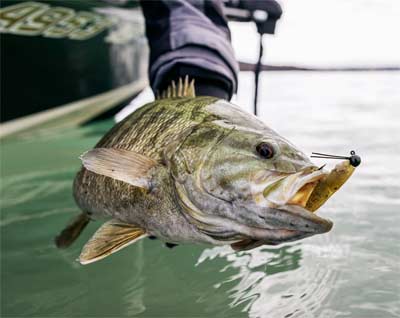
They’re the bad boys of the black bass clan, the hard chargers with voracious appetites and attitude to spare. Smallmouth bass are widely distributed throughout the continental U.S., but while there’s never any confusion between these fish and largemouth, the northern and southern fish are different creatures.
According to the U.S. Geological Survey, the smallmouth’s native range comprises the St. Lawrence River and Great Lakes, Hudson Bay (Red River), and the Mississippi River basins from southern Quebec to North Dakota and south to northern Alabama and eastern Oklahoma, along with Atlantic and Gulf slope drainages from Virginia to central Texas. Stocking efforts have greatly expanded the smallmouth range.
With multiple native lineages identified by science, the fish living in deep, glacially formed northern waters display unique characteristics.
Different Shapes: Shorter growing seasons and colder waters, plus the abundance of forage (particularly gobies, where they’re present), typically yield short, fat northern smallmouth shaped like footballs. Southern smallies, with their nearly year-round growing season, end up shaped more like a largemouth with brown coloration and a less pronounced front end.
Different Demeanors: It seems like southern smallmouth require more precise casts, while northern smallies are more forgiving. Water clarity explains much of this, as good visibility in southern fisheries may only be 2-3 feet while eyeballing fish at 20 feet is commonplace in northern fisheries.
Also, consider that smallmouth in northern waters can certainly turn picky, especially under intense fishing pressure, but when they’re in a good mood, you only have to get a bait within a few feet, and they’ll usually run over and eat it. During the spawn, northern smallies can become aggressively territorial, so anything even close to their bed gets crushed.
Different Preferences: With the exception of spawning season, we typically think of smallmouth roaming deeper northern waters, often in 30 feet or more. Extreme clarity may make the fish feel less secure in shallower areas, while more water over their heads means a more relaxed fish. An efficient sight feeder, smallmouth want water clarity, but they also understand the importance of stealth.
Southern smallies generally contend with more off-colored water, so they don’t mind living shallow. These fish often show up on deep offshore ledges and other structure, but rocks and gravel bars in 10 feet or less find many of the fish taking advantage of the shallow light penetration.
As far as weather, northern fish are decidedly more tolerant to cold, while their southern counterparts react more decidedly to chilly weather. Both species instinctively gravitate to current for feeding. Still, southern fish that spend a lot of time in tailraces tend to move away from strong current in the wintertime to minimize their work and preserve maximum calories for warmth.
Another difference, northern smallmouth seem to be most active during sunny, calm days when they enjoy maximum visibility. Southern fish tend to side with the largemouth crowd and favor windier days with cloudy or overcast skies.
What They Like: Forage base typically determines what smallmouth prefer and what anglers throw. This varies regionally, but the southern fish tend to eat larger prey like threadfin shad, while the northern smallmouth target a lot of smaller minnows, shiners, and juvenile perch. The exception is larger crawfish and gobies (Great Lakes, St. Lawrence River, etc.).
Northern smallmouth often swim 20 feet from the bottom to blast topwater baits, but the majority of work is done below the surface. When the fish feed shallow, a Mustad Arm-Lock Spinnerbait will tempt big bites, while tubes, dropshots with Mustad TitanX Tungsten Skinny Dropshot Weights, Ned rigs, marabou jigs, and soft plastic worms, craws or lizards Carolina-rigged on Mustad Grip-Pin Big Bite hooks with Mustad Tungsten TitanX Carolina Weights cover the deeper work.
For southern smallmouth, a mix of topwaters, crankbaits, bladed jigs, jerkbaits, and soft body swimbaits on Mustad Alpha-Point Infiltrator Swim Hook will close the deal. Backing up the reaction baits with dropshots, football head jigs and shakey heads like the Mustad Elite Stand Up Jig will keep the rods bent.
Regardless of where and how you catch a smallmouth, plan on a spirited fight with lots of boat-side antics and big-air leaps. Take your time, trust your tackle, and let the fish run out of steam.
